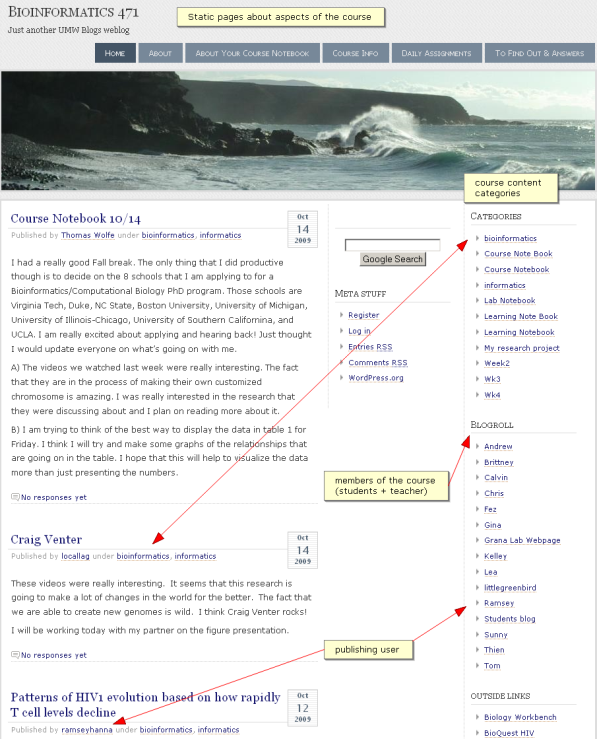
Silos to keep stuff in
Let’s face it, Moodle is a silo. And the problem is that the past four or so years we’ve been running Moodle we’ve got into the Moodle way of thinking. We think of “resources”, “activities” and perhaps “the gradebook” and everything is squirrelled into the tidy Moodle silo.
Perversely, on campuses saddled with Blackboard professors have been more willing to think outside the silo. A good example of this thinking is the WordPress MU site at the University of Mary Washington. Here’s a couple of screenshots of their wonderfully designed UMW Blogs front page:

UMW Blogs front page navigation

UMW Blogs front page navigation : open Support
Not only is this a nicely designed site which makes it attractive to use there are some nifty courses that are hosted here as well as whole departments such as Department of History and American Studies. As an example let’s take Bioinformatics 471. Here’s a screenshot of the front page:
All the labels are oriented around the course and course activities. It’s effectively an active multi-input web site. The links along the top of the page point to course How Tos (Information, assessments, about pages, etc). These are easy to create in WordPress via Pages and can be easily nested. Students post entries (such as this one entitled ‘More HIV research‘) with a category name used by the class blog, such as bioinformatics, Learning Note Book, etc. These entries get magically (via RSS I assume) sucked into the course blog and filed under the same category. The course participants are listed under the Blogroll (which could perhaps have been renamed ‘Participants’) and clicking on the names takes you to the individual’s blog. However, clicking on the ‘Published by’ person’s name lists all the posts made so far into the class blog.
This makes the whole course a really ongoing participatory exercise. Students are real co-constructors here and not just passive recipient of ‘resources’. You can see how much they struggle with concepts and it’s exciting to follow their latest discoveries. However, there’s still a need for the course management silo, the Moodle as it were, to post grades and copyrighted materials.
I would be interested in talking to the prof who runs this course to find out how he got into it, how easy he feels it is to use, and how much effort it takes on his part to keep it running (my guess here is that making regular comments on students postings is key to keeping student participation at a high level).

